高考英语第一轮复习(语法)【高考推荐】
- 格式:doc
- 大小:136.50 KB
- 文档页数:4

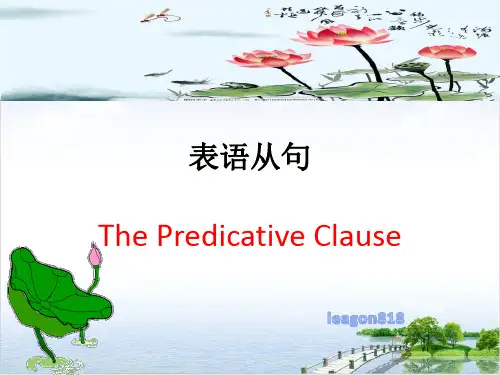
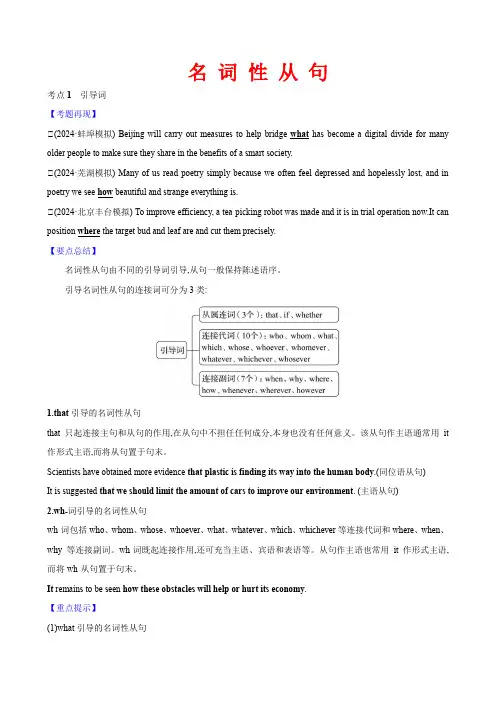
名词性从句考点1引导词【考题再现】①(2024·蚌埠模拟) Beijing will carry out measures to help bridge what has become a digital divide for many older people to make sure they share in the benefits of a smart society.①(2024·芜湖模拟) Many of us read poetry simply because we often feel depressed and hopelessly lost, and in poetry we see how beautiful and strange everything is.①(2024·北京丰台模拟) To improve efficiency, a tea-picking robot was made and it is in trial operation now.It can position where the target bud and leaf are and cut them precisely.【要点总结】名词性从句由不同的引导词引导,从句一般保持陈述语序。
引导名词性从句的连接词可分为3类:1.that引导的名词性从句that只起连接主句和从句的作用,在从句中不担任任何成分,本身也没有任何意义。
该从句作主语通常用it 作形式主语,而将从句置于句末。
Scientists have obtained more evidence that plastic is finding its way into the human body.(同位语从句)It is suggested that we should limit the amount of cars to improve our environment. (主语从句)2.wh-词引导的名词性从句wh-词包括who、whom、whose、whoever、what、whatever、which、whichever等连接代词和where、when、why等连接副词。
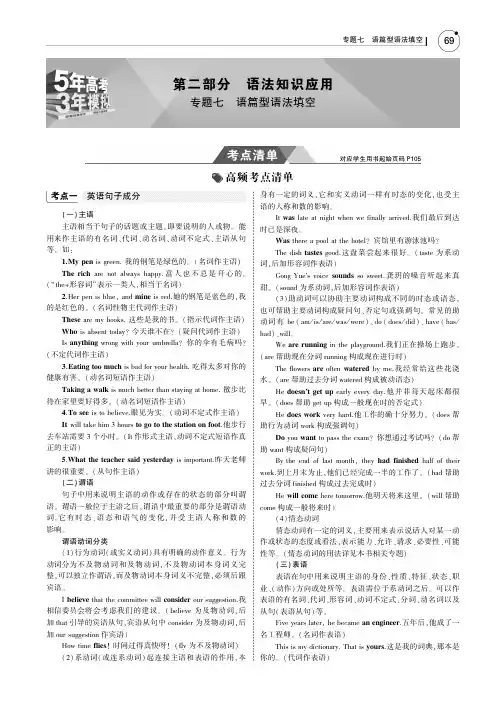
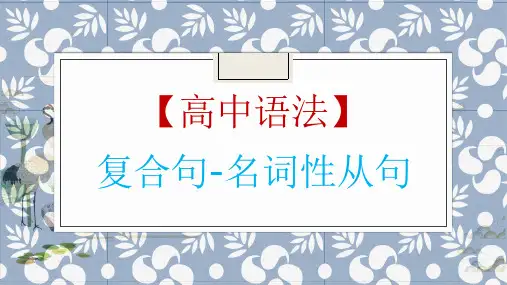
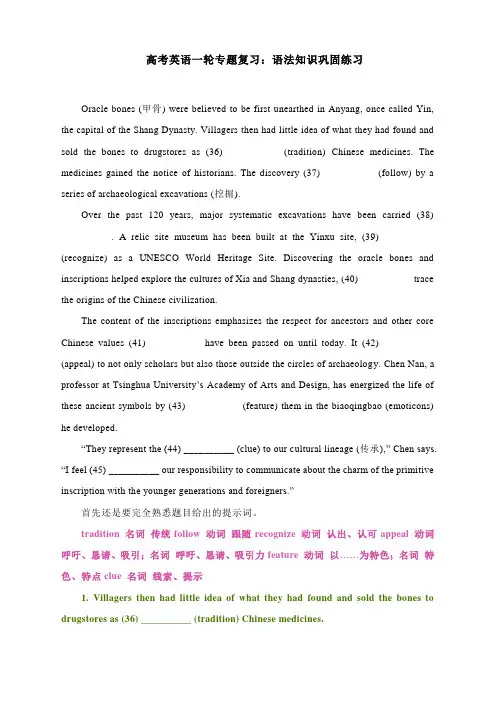
高考英语一轮专题复习:语法知识巩固练习Oracle bones (甲骨) were believed to be first unearthed in Anyang, once called Yin, the capital of the Shang Dynasty. Villagers then had little idea of what they had found and sold the bones to drugstores as (36) __________ (tradition) Chinese medicines. The medicines gained the notice of historians. The discovery (37) __________ (follow) by a series of archaeological excavations (挖掘).Over the past 120 years, major systematic excavations have been carried (38) __________. A relic site museum has been built at the Yinxu site, (39) __________ (recognize) as a UNESCO World Heritage Site. Discovering the oracle bones and inscriptions helped explore the cultures of Xia and Shang dynasties, (40) __________ trace the origins of the Chinese civilization.The content of the inscriptions emphasizes the respect for ancestors and other core Chinese values (41) __________ have been passed on until today. It (42) __________ (appeal) to not only scholars but also those outside the circles of archaeology. Chen Nan, a professor at Tsinghua University’s Academy of Arts and Design, has energized the life of these ancient symbols by (43) __________ (feature) them in the biaoqingbao (emoticons) he developed.“They represent the (44) __________ (clue) to our c ultural lineage (传承),” Chen says. “I feel (45) __________ our responsibility to communicate about the charm of the primitive inscription with the younger generations and foreigners.”首先还是要完全熟悉题目给出的提示词。
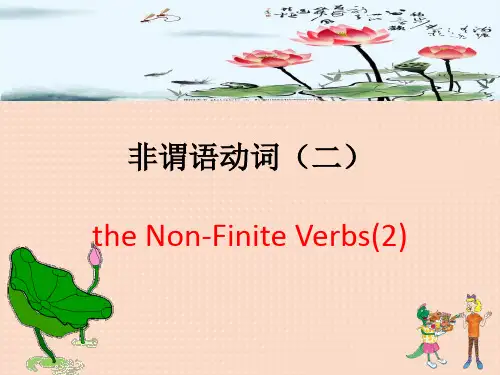
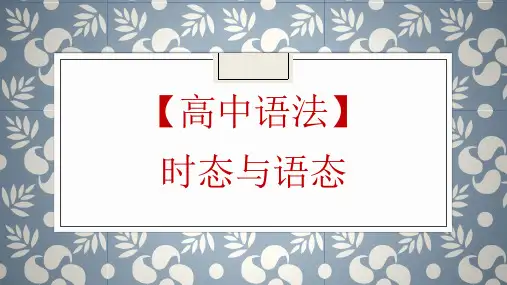
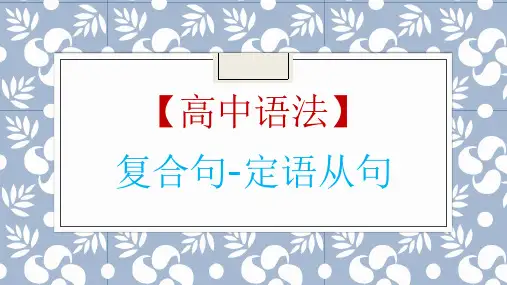
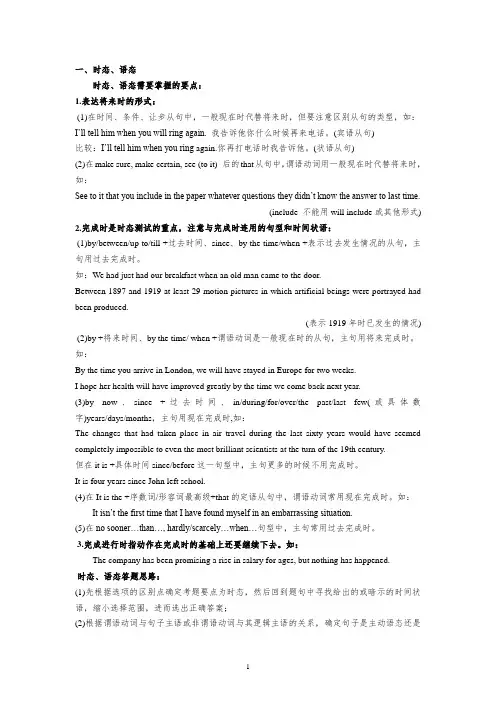
一、时态、语态时态、语态需要掌握的要点:1.表达将来时的形式:(1)在时间、条件、让步从句中,一般现在时代替将来时,但要注意区别从句的类型,如:I’ll tell him when you will ring again. 我告诉他你什么时候再来电话。
(宾语从句)比较:I’ll tell him when you ring again.你再打电话时我告诉他。
(状语从句)(2)在make sure, make certain, see (to it) 后的that从句中,谓语动词用一般现在时代替将来时,如:See to it that you include in the paper whatever questions they didn’t know the answer to last time.(include 不能用will include或其他形式) 2.完成时是时态测试的重点,注意与完成时连用的句型和时间状语:(1)by/between/up to/till +过去时间、since、by the time/when +表示过去发生情况的从句,主句用过去完成时。
如:We had just had our breakfast when an old man came to the door.Between 1897 and 1919 at least 29 motion pictures in which artificial beings were portrayed had been produced.(表示1919年时已发生的情况) (2)by +将来时间、by the time/ when +谓语动词是一般现在时的从句,主句用将来完成时。
如:By the time you arrive in London, we will have stayed in Europe for two weeks.I hope her health will have improved greatly by the time we come back next year.(3)by now、since +过去时间、in/during/for/over/the past/last few(或具体数字)years/days/months,主句用现在完成时,如:The changes that had taken place in air travel during the last sixty years would have seemed completely impossible to even the most brilliant scientists at the turn of the 19th century.但在it is +具体时间since/before这一句型中,主句更多的时候不用完成时。
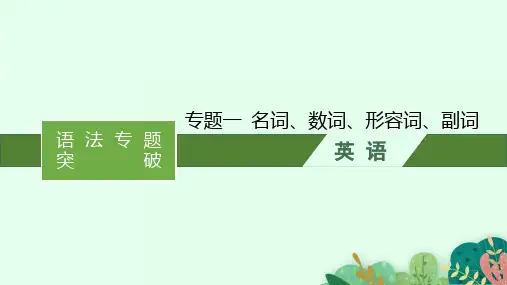
入舵市安恙阳光实验学校高考语法专题九非谓语动词语法训练10分钟一1.(2013·课标Ⅰ卷)The sunlight is white and blinding,________hard -edged shadows on the ground.A.throwing B.being thrownC.to throw D.to be thrown解析:考查非谓语动词。
句意:阳光明媚而刺眼,在地上投下了轮廓鲜明的影子。
主语sunlight与throw shadows之间为主动关系,故选A。
答案:A2.(2013·北京卷)________the course very difficult,she decided to move to a lower level.A.Find B.FindingC.To find D.Found解析:考查非谓语动词。
句意:她发现这门课程非常难,决定转学一门较低水平的(课程)。
she与find之间是逻辑上的主谓关系,故用现在分词表主动,表伴随。
答案:B3.(2013·天津卷)In some languages,100 words make up half of all words________in daily conversations.A.using B.to useC.having used D.used解析:考查非谓语动词。
句意:在一些语言中,100个词构成了日常对话使用的所有词汇的一半。
分析句子成分可知,use和words之间是动宾关系,用过去分词表被动。
答案:D4.(2013·北京卷)When we saw the road________with snow,we decided to spend the holiday at home.A.block B.to blockC.blocking D.blocked解析:考查非谓语动词。
定语从句一、概念:在复合句中,修饰某一名词或代词的从句叫定语从句。
如:I want to marry a rich man.定语I want to marry a man who is tall, rich and handsome. (从句谓语和先行词一致)先行词定语从句定语从句所修饰的词叫先行词;定语从句用关系词(_____________ _____________)来引导,关系词放在先行词与定语从句之间起连接作用,同时又作从句中的一个成分。
1)关系代词:______________________________________2)关系副词:______________________________________二、关系词的用法:(一)关系代词的用法:1) who, whom, that这些词代替的先行词是人的名词或代词,在从句中作主语或宾语。
例如:He is the man who/that wants to marry me.他就是那个想娶我的人。
(who/that在从句中作主语)He is the man whom/ that I want to marry.他就是我想嫁的那个人。
(whom/that在从句中作宾语)合并:1.The girl is my sister. The girl is standing on the stage._______________________________________________________2.I don’t know the boy. The boy is in blue shirt._______________________________________________________3.My brother likes the singers. The singers write their own music._______________________________________________________翻译:1那就是教我们英语的老师。
(英语)高考英语一轮复习专项训练英语语法填空含解析一、高中英语语法填空1.阅读下面短文,在空白处填入1个适当的单词或括号内单词的正确形式。
As Alison Gopnik described in her recent book, there are two kinds of parents in modern America: The Carpenter and the Gardener. The "carpenter" thinks that his or her child can________(shape). "The idea is that if you just do the right things, get the right skills and read the right books, you're going to be able to turn your child ________a particular kind of adult," she saidThe "gardener", however is seldom concerned about ________ (control) what the child will become and instead provides a protected space ________explore). The style is all about:" creating a rich, nutritious but also variable, diverse, active ecosystem".Gopnik, a psychology and philosophy professor at the University of California, Berkeley, said." Many parents are carpenters, and ________is really necessary for them to bring up their children." She spent decades researching children's development and finally ________(find) that parents often focused too much on what their children would be as adults. The harm is that parents and their children may become________ (anxiety), tense or unhappy."We're so concerned about our children ________ we think have difficulty mastering their own future that we're unwilling to allow them to ________ (free) explore the world." she says. The truth is that the ________ (little) that parents worry about outcomes, the better their children may live in life.【答案】be shaped;into;controlling;to explore;it;found;anxious;who/that;freely;less【解析】【分析】本文是一篇说明文,介绍了现代美国存在的木匠型父母和园丁型父母的特点。
高考英语第一轮复习(语法)——情态动词
1、情态动词的基本用法
(1)can、be able to 和could
①can和be able to都表示能力,意思上没多大区别。
但can只有现在和过去时,而be able to则有更多的形式。
但当成功地完成某一具体动作时,通常不用could而用was/were able to来表示。
这时was/were able to 相当于managed to,表示经过一番努力,终于能够完成某事。
如:
Can you use chopsticks?
The wounded man still was able to get to the village and was saved in the end.
②can和could
can和could都可以表示能力、技能、许可、建议或请求和可能性。
但比较委婉客气地提出问题或陈述看法,一般用could,回答时则用can。
如:
Could you help me carry the bag?
Can I help you?
(2)may/might
①may/might表示可能,但may比might可能性大。
如:-Why isn’t he in class? He may be sick.(生病的可能性较大)
— He might be sick.(生病的可能性较小)
②may/might表示“允许”,may用于现在时或将来时,might常用在间接引语中表过去时,但might也可用于现在时间,表示比较委婉的语气,回答用may。
如:He says we may leave.
He said we might leave.
③may / might 表示建议或请求,但might比may 更客气,意思更肯定而无过去时态的含义。
Yes, you can / may.
—May / Might I use your bike? —
No, you mustn’t
(3)must
①must表示必须,应该,没有时态变化。
如:
You must do everything as I do.
②must表示肯定的推测。
如:
The light is still on, so he must be at home.
③mustn’t 表示禁止做某事。
如:
You mustn’t smoke in the office.
(4)have to
have to 表示“必须、不得不”,是由于某种外界(客观)原因而“必须”,“不得不”做某事,也可表示经常的或习惯性的事“必须”做。
have to的否定形式表示不必。
have to可用于多种时态中。
如:
You will have to clean your own boots when you join the army.
I have to be at my office every evening.
(5)should / ought to
①should和ought to表示应当、应该,前者比后者语气轻。
如:
You should / ought to work hard.
②should / ought to work hard.
Since she is not here, whe should / ought to be in the classroom.
③should / ought to的否定形式表示禁止之意。
如:
Children shouldn’t smoke.
④should可表示陈述意见,推出建议或请求;而ought to可以表示劝告之意。
如:
You ought to respect your parents.
He suggested that they should leave at once.
(6)will / would
①will 用于各种人称表示“意志”、“意愿”或“决心”等,否定式won’t + 动词。
如:
I will tell you all about it.
Tom won’t do such a thing.
②will用于疑问句中,常用在第二称时表示说话人向对方提出“请求”或“询问”如:
Will you please tell her the news when you see her?
③will 表示习惯性的动作,有“总是”、“惯于”的含义。
如:
Fish will die out of water.
④would 表示客气的请求、建议或意愿。
如:
Would you please be quiet?
Would you like coffee?
⑤would 表示过去反复发生的动作。
如:
When I passed my school I would see my teachers who taught me 5 years ago.
(7)need
need 作“必要”讲,既可作情态动词,也可作实义动词。
作实义动词时后面的动词不定式要带to,其变化与一般动词相同。
如:
I need to think it over.
—Need you go now? —Yes, I must./No, I needn’t
(8)dare
dare表示“敢”的意思。
作为情态动词时,主要用在疑问句和否定句中。
dare 若作实义动词,后面可带to的不定式,此时to也可以省略。
dare与need的用法相似。
如:
How dare you say that?
She doesn’t date(to)ask her father.
(9)used to
used to表示过去常常发生的动作或存在的习惯,但现在已不复存在了。
如:He used to smoke.
(10)shall
①shall作为情态动词用于第二、三人称,表示说话人的意愿,有“命令”、“警告、威胁、强制”和“允许”等意思。
如:
We shall do as our teacher says.
You shall have the book as soon as I finish it.
②在疑问句中,shall用于征求对方的意见或请求指示,常用于第一、第三人称。
如:
Where shall he wait for us?
Shall we go out for a walk?
2、情态动词表示推测或判断的用法
下表即是表示推测的情态动词使用的场合:
情态动词对现在和未来的推测对过去的推测使用场合
must must + 动词原形 must have done 肯定句
may / might may / might + 动词原形 May / might have done 肯定句、否定句
can /could can / could do Can / could have done 否定句、疑问名(could 可用于肯定句)
should 用来表示一种估计的情况“按理会/估计会”should do/be should have done 肯定句、否定句、疑问句
例如:
It must have rained last night.
She may not be at home. = It is possible that she is not at home.
She can’t be at home. = It is impossible that she is at home.
They should be there right now.
3、情态动词在虚拟语气中的用法
情态动词用于虚拟语气中表示责备的感情色彩,用法如下:
(1)should have done表示“本来应该做某事而实际上未做”,而shouldn’t have done则表示“本不应该做某事而实际上做了”。
如:
You should have told me about it earlier.
Y ou shouldn’t have said such words to your parents.
(2)ought to have done也表示“本应该……”而ought not to have done 则意为“本不应该……”。
如:
You ought to have told me about it earlier.
You ought not to have said such words to your parents.
(3)needn’t have done表示“本无必要做某事而实际上做了”。
如:
You needn’t have walked so quickly since time was enough.
(4)could have done表示“本来有可能……而事实上未做到”。
如:
I could have come on time, but my car broke on the way.。